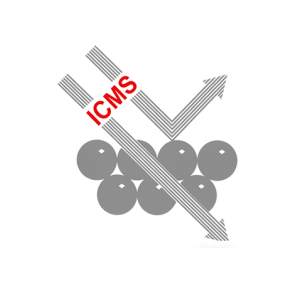Scientific Papers in SCI
2021
2021
Química de Superficies y Catálisis
Recent Advances in the Bronsted/Lewis Acid Catalyzed Conversion of Glucose to HMF and Lactic Acid: Pathways toward Bio-Based Plastics
Megias-Sayago, C; Navarro-Jaen, S; Drault, F; Ivanova, SCatalysts, 11 (2021) 1395 DOI: 10.3390/catal11111395

Abstract
One of the most trending topics in catalysis recently is the use of renewable sources and/or non-waste technologies to generate products with high added value. That is why, the present review resumes the advances in catalyst design for biomass chemical valorization. The variety of involved reactions and functionality of obtained molecules requires the use of multifunctional catalyst able to increase the efficiency and selectivity of the selected process. The use of glucose as platform molecule is proposed here and its use as starting point for biobased plastics production is revised with special attention paid to the proposed tandem Bronsted/Lewis acid catalysts.
November, 2021 · DOI: 10.3390/catal11111395
Fotocatálisis Heterogénea: Aplicaciones
Polyaniline coated tungsten trioxide as an effective adsorbent for the removal of orange G dye from aqueous media
Hsini, A.; Naciri, Y.; Bouziani, A.; Aarab, N.; Essekri, A; Imgharn, A.; Laabd. M.; Navío, J.A.;Puga, F.; Lakhmirid, R.; Albourine, A.RSC Advances, 11 (2021) 31272-31283 DOI: 10.1039/D1RA04135E

Abstract
In this work, the core–shell PANI@WO3 composite was obtained from the reaction of aniline monomer polymerization with WO3 particles; sodium persulfate was used as an oxidant. Various analytical techniques such as scanning electron microscopy (SEM-EDS), X-ray diffraction (XRD), Fourier transform infrared spectroscopy (FTIR), Brunauer–Emmett–Teller (BET), and X-ray photoelectron spectroscopy (XPS) were used to characterize the as-prepared PANI@WO3 adsorbent, which well confirmed that the WO3 particles were coated by polyaniline polymer. The PANI@WO3 composite was tested as an adsorbent to remove reactive orange G (OG) for the first time. pH, adsorbent dose, contact time, initial dye concentration, and temperature were systematically investigated in order to study their effect on the adsorption process. The experimental findings showed that the PANI@WO3 composite has considerable potential to remove an aqueous OG dye. Langmuir and Freundlich's models were used to analyze the equilibrium isotherms of OG dye adsorption on the PANI@WO3 composite. As a result, the best correlation of the experimental data was provided by the Langmuir model, and the maximum capacity of adsorption was 226.50 mg g−1. From a thermodynamic point of view, the OG dye adsorption process occurred spontaneously and endothermically. Importantly, PANI@WO3 still exhibited an excellent adsorption capability after four regeneration cycles, indicating the potential reusability of the PANI@WO3 composite. These results indicate that the as prepared PANI@WO3 composite could be employed as an efficient adsorbent and was much better than the parent material adsorption of OG dye.
November, 2021 · DOI: 10.1039/D1RA04135E
Materiales Ópticos Multifuncionales
Ultrastrong Exciton-Photon Coupling in Broadband Solar Absorbers
Bujalance, C; Esteso, V; Calio, L; Lavarda, G; Torres, T; Feist, J; Garcia-Vidal, FJ; Bottari, G; Miguez, HJournal of Physical Chemistry Letters, 12 (2021) 10706-10712 DOI: 10.1021/acs.jpclett.1c02898
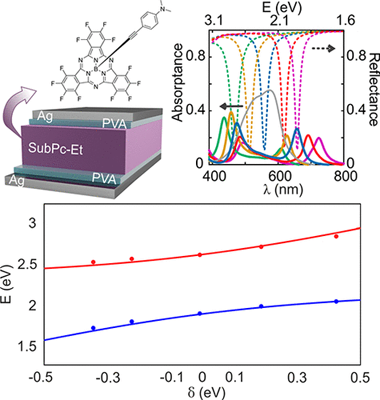
Abstract
The recent development of organic polaritonic solar cells, in which sunlight absorbers and photon modes of a resonator are hybridized as a result of their strong coupling, has revealed the potential this interaction offers to control and enhance the performance of these devices. In this approach, the photovoltaic cell is built in such a way that it also behaves as an optical cavity supporting spectrally well-defined resonances, which match the broad absorption bands of the dyes employed. Herein we focus on the experimental and theoretical analysis of the specific spectral and angular optical absorption characteristics of a broadband light harvester, namely a subphthalocyanine, when operating in the ultrastrong coupling regime. We discuss the implications of having a broad distribution of oscillator strengths and demonstrate that rational design of the layered structure is needed to optimize both the spectral and the angular response of the sunlight harvester dye.
November, 2021 · DOI: 10.1021/acs.jpclett.1c02898
Química de Superficies y Catálisis
K-Promoted Ni-Based Catalysts for Gas-Phase CO2 Conversion: Catalysts Design and Process Modelling Validation
Gandara-Loe, J; Portillo, E; Odriozola, JA; Reina, TR; Pastor-Perez, LFrontiers in Chemistry, 9 (2021) 785571 DOI: 10.3389/fchem.2021.785571
Abstract
The exponential growth of greenhouse gas emissions and their associated climate change problems have motivated the development of strategies to reduce CO2 levels via CO2 capture and conversion. Reverse water gas shift (RWGS) reaction has been targeted as a promising pathway to convert CO2 into syngas which is the primary reactive in several reactions to obtain high-value chemicals. Among the different catalysts reported for RWGS, the nickel-based catalyst has been proposed as an alternative to the expensive noble metal catalyst. However, Ni-based catalysts tend to be less active in RWGS reaction conditions due to preference to CO2 methanation reaction and to the sintering and coke formation. Due to this, the aim of this work is to study the effect of the potassium (K) in Ni/CeO2 catalyst seeking the optimal catalyst for low-temperature RWGS reaction. We synthesised Ni-based catalyst with different amounts of K:Ni ratio (0.5:10, 1:10, and 2:10) and fully characterised using different physicochemical techniques where was observed the modification on the surface characteristics as a function of the amount of K. Furthermore, it was observed an improvement in the CO selectivity at a lower temperature as a result of the K-Ni-support interactions but also a decrease on the CO2 conversion. The 1K catalyst presented the best compromise between CO2 conversion, suppression of CO2 methanation and enhancing CO selectivity. Finally, the experimental results were contrasted with the trends obtained from the thermodynamics process modelling observing that the result follows in good agreement with the modelling trends giving evidence of the promising behaviour of the designed catalysts in CO2 high-scale units.
November, 2021 · DOI: 10.3389/fchem.2021.785571
Materiales Nanoestructurados y Microestructura
Influence of helium incorporation on growth process and properties of aluminum thin films deposited by DC magnetron sputtering
Ibrahim, S; Lahboub, FZ; Brault, P; Petit, A; Caillard, A; Millon, E; Sauvage, T; Fernandez, A; Thomann, AlSurface & Coatings Technology, 426 (2021) 127808 DOI: 10.1016/j.surfcoat.2021.127808
Abstract
The effect of helium content on the morphology, crystallinity, and composition of aluminum films was investigated by depositing He-loaded Al films onto Si substrates via direct current (DC) magnetron sputtering in different Ar/He plasma mixtures. Three different plasma regimes were identified depending on the percentage of He in the gas phase. For a low He to total gas ratio (ΓHe ≤ 70%), the plasma is dominated by argon, where Ar+ ions contribute to sputter out the target atoms. The films deposited in this regime exhibited the classical dense columnar structure and contain very low amount of He (below 2%). Then, as ΓHe increases, helium ions begin to be formed and more fast He neutrals reach the substrate, affecting the film growth. As He amount increased in the gas phase up to 95%, the proportion of He inserted in the films rised up to ⁓15 at. %. Moreover, bubbles/porosity were formed inside the films; those obtained in pure He plasma presented a highly porous fiberform nanostructure. All results confirmed that the modification of the film characteristics was related to the change of the deposition conditions when Ar was replaced by He and to the insertion/release mechanisms of He during the growth.
November, 2021 · DOI: 10.1016/j.surfcoat.2021.127808
Materiales de Diseño para la Energía y Medioambiente
By-products revaluation in the production of design micaceous materials
Mouchet, A; Raffin, F; Cota, A; Osuna, FJ; Pavon, E; Alba, MDAplied Clay Science, 214 (2021) 106292 DOI: 10.1016/j.clay.2021.106292

Abstract
One of the main objectives of a sustainable development and circular economy is the recycling of by-products generated in industrial and agricultural production processes. One of the possible solution is the use of such by-product materials in the synthesis of environmental adsorbents. In the current research, we present the synthesis of a high charge swelling mica with enhance adsorbent properties from blast furnace slag and rice husk ash. Moreover, to ensure the sustainable synthesis a natural bentoniteis used as Si and Al source. Thus, the current study investigated the fabrication of swelling high charged micas, Na-Mn (n (layer charge) = 2 or 4), from FEBEX bentonite, blast furnace slag and rice husk ash thorough the NaCl melt method. The reaction yield, cation framework distribution and structural characteristic of micas have been studied thorough X-ray Diffraction and Solid State Nuclear Magnetic Resonance. The yields of Na-Mn synthesis and degree of purity of the mica depends on the nature of these precursors. Thus, a sustainable, non-expensive and environmental friendly process has been evaluated.
November, 2021 · DOI: 10.1016/j.clay.2021.106292
Materiales Coloidales
NaY(MoO4)(2)-based nanoparticles: synthesis, luminescence and photocatalytic properties
Nunez, NO; Gomez-Gonzalez, E; Calderon-Olvera, RM; Becerro, AI; Colon, G; Ocana, MDalton Transactions, 50 (2021) 16539-16547 DOI: 10.1039/d1dt02365a
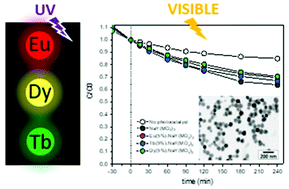
Abstract
Abstract
We report on a novel synthesis method, which produces NaY(MoO4)(2) nanoparticles having an almost spherical shape and hydrophilic character. The procedure is also suitable for the preparation of NaY(MoO4)(2)-based nanophosphors by doping this host with lanthanide cations (Eu3+, Tb3+ and Dy3+), which, under UV illumination, exhibit intense luminescence whose color is determined by the selected doping cation (red for Eu3+, green for Tb3+ and yellow for Dy3+). The effects of the cations doping level on the luminescent properties are analyzed in terms of emission intensities and luminescent lifetime, to find the optimum phosphors. Finally, the performance of these nanophosphors and that of the undoped system for the photocatalytic degradation of rhodamine B, used as a model compound, is also analyzed.
November, 2021 · DOI: 10.1039/d1dt02365a
Nanotecnología en Superficies y Plasma
Extraction of microstructural parameters from sculptured thin films nanoindentation
Gaillard, Y; Jimenez-Pique, E; Oliva-Ramirez, M; Rico, VJ; Gonzalez-Elipe, ARSurface & Coatings Technology, 425 (2021) 127696 DOI: 10.1016/j.surfcoat.2021.127696
Abstract
This work deals with the indentation analysis of nanocolumnar thin films and the difficulties encountered to deduce relevant mechanical parameters by this methodology. SiO2 thin films prepared by physical vapour oblique angle deposition with different nanocolumnar microstructures have been subjected to indentation analysis. Despite the fact that the films had been made of the same material, deposited on the same substrate and had similar thickness, their indentation responses were different and depended on their particular microstructure. It has been also realised that the measured hardness and elastic modulus variation with the indentation depth were length scale dependent and that there is not a unique analytical thin-film nanoindentation model to extract the mechanical properties from the experimental nanoindentation curves. To overcome these limitations a numerical finite element model (FEM) of the nanocolumnar coatings has been built to figure out the contributions of the different physical phenomena intervening in the indentation process. This FEM simulation relies on a description of the elasto-plastic microstructural units of the coatings and the contact friction interactions between them. Based on this simulation a parametrical representation, incorporating two length scales and the contributions of densification and/or the buckling of nanocolumnar units, has been developed to account for the evolution of the apparent elastic modulus deduced from numerical indentation tests. A Hall-Petch modification of this description considering two length scales instead of the common approximation considering a single length scale has rendered the best agreement with the elastic values determined experimentally. Although, at the present stage, the particular microstructure of the films can not be deduced from the evolution of their elastic moduli with the indentation depth, the obtained results and their interpretation constitute a first though essential step for the elaboration of an inverse analysis methodology capable of correlating microstructure and elastic response of nanocolumnar coatings.
November, 2021 · DOI: 10.1016/j.surfcoat.2021.127696
Materiales de Diseño para la Energía y Medioambiente
Impact of flame confinement with inert ceramic foams on the particulate emissions of domestic heating systems
Ciria, D; Orihuela, MP; Becerra, JA; Chacartegui, R.; Ramirez-Rico, J.Fuel, 304 (2021) 121264 DOI: 10.1016/j.fuel.2021.121264
Abstract
Small solid biomass combustion systems are among the main contributors to the global particulate emissions share, and cheap, efficient abatement systems are not yet available for them. The placement of inert porous material to confine the combustion region is being recently explored as a possible mitigation system for this kind of pollution. However, given the complexity of biomass thermochemical decomposition processes, it is challenging to justify the performance of these systems on the basis of a physicochemical understanding. A foundational experiment-based study is carried out in this work to understand how combustion confinement affects the particulate emissions production mechanisms. A combustion unit was designed and built to systematically test ceramic foams with different porosities: keeping constant airflow and fuel feed rates. A comprehensive characterisation study was carried out on the solid biomass fuel, the temperature profile, the particulate emissions, and the remaining solid residue. The results evidenced that the use of foams has a substantial impact on the temperature distribution in the combustion chamber. The higher the cell density of the foam, the higher and more homogeneous are the temperatures reached in the combustion bed. This fact improved the thermal decomposition process of the pellets due to a better air-fuel mixture, leading to a reduction of the solid particulate matter emissions by more than 70%. These findings suggest that the use of an inert porous material above the combustion region might be a feasible solution for particulate emission control in small-size biomass combustion technology.
November, 2021 · DOI: 10.1016/j.fuel.2021.121264
Química de Superficies y Catálisis
Assessing the impact of textural properties in Ni-Fe catalysts for CO2 methanation performance
Gonzalez-Castano, M; de Miguel, JCN; Boelte, JH; Centeno, MA; Klepel, O; Arellano-Garcia, HMicroporous and Mesoporous Materials, 327 (2021) 111405 DOI: 10.1016/j.micromeso.2021.111405
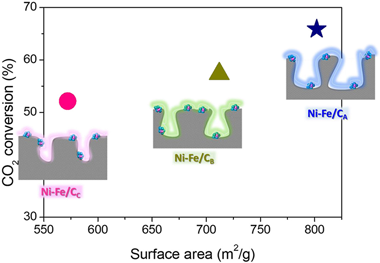
Abstract
In heterogeneous catalysis, the benefits of employing adequate textural properties on the catalytic performances are usually stated. Nevertheless, the quantification of the extent of improvement is not an easy task since variations on the catalysts' specific areas and pore structures might involve modifications on a number of other surface catalytic features. This study establishes the impact of the catalyst textural properties on the CO2 methanation performance by investigating bimetallic Ni–Fe catalysts supported over carbon supports with different textural properties regarding surface area and pore structure. The comparable metal loading and dispersions attained for all systems enabled establishing forthright relationships between the catalyst textural properties and CO2 methanation rate. Once the influence of the external mass diffusions on the catalysts’ performance was experimentally discarded, the estimated Thiele modulus and internal effectiveness (φ and ηEff) values showed that the catalyst performance was majorly governed by the surface reaction rate whilst the pore size affected in no significant manner within the examined range (Dpore = 10.2 to 5.8 nm). Therefore, the rapport between the catalyst performance and surface area was quantified for the CO2 methanation reaction over Ni–Fe catalysts: increasing the surface area from 572 to 802 m2/g permit obtaining ca. 10% higher CO2 conversions.
November, 2021 · DOI: 10.1016/j.micromeso.2021.111405
Reactividad de Sólidos
Pure perovskite BiFeO3-BaTiO3 ceramics prepared by reaction flash sintering of Bi2O3-Fe2O3-BaTiO3 mixed powders
Taibi, A; Chaguetmi, S; Sánchez-Jiménez, PE; Perejón, A; García, JE; Satha, H; Pérez-Maqueda, LACeramics International, 47 (2021) 26947-26954 DOI: 10.1016/j.ceramint.2021.06.108
Abstract
In this work, the 0.67BiFeO(3)-0.33BaTiO(3) ferroelectric ceramic was prepared by Reaction Flash Sintering (RFS). This preparation technique combines synthesis and sintering in a single Flash experiment. The starting oxides reacted during the flash to produce a stoichiometric well-sintered solid solution at a temperature of 858 degrees C by applying a modest field of 35 V cm(-1). The process takes place in a matter of seconds, which allows obtaining a pure perovskite structure without secondary phases. X-ray diffraction (XRD) results show the mixture of rhombohedral and pseudocubic phases expected for a composition that lies within a morphotropic phase boundary (MPB) region, since a significant splitting is observed in the reflections at 2 theta values of 39 degrees and 56.5 degrees. The microstructure exhibit a peculiar bimodal grain size distribution that determines the electrical properties. As compared with previous results, flash-prepared 0.67BiFeO(3)-0.33BaTiO(3) evidences smaller grain size, as well as slightly lower remanent polarization (P-r) and smaller coercive field (E-c) under similar electric fields. It is also demonstrated that the preparation by RFS provides benefits regarding electrical energy consumption.
October, 2021 · DOI: 10.1016/j.ceramint.2021.06.108
Nanotecnología en Superficies y Plasma
Photonic sensor systems for the identification of hydrocarbons and crude oils in static and flow conditions
Gil-Rostra, J; Quintero-Moreno, S; Rico, VJ; Yubero, F; Sanza, FJ; Casquel, R; Gallo-Valverde, E; Jara-Galan, ME; Sanz-Sanz, P; Holgado, M; Gonzalez-Elipe, ARSensors and Actuators B-Chemical, 344 (2021) 130265 DOI: 10.1016/j.snb.2021.130265
Abstract
Identification of hydrocarbons and crude oils is typically carried out with samples that, taken from natural sources or refineries, must be brought to the laboratory for their analysis with rather sophisticated instruments. Alternatively, "in situ" procedures have been also developed for this purpose. In this work, we propose the use of a series of several sensor systems based on photonic transducers in the form of chips for the identification and classification of crude oils and hydrocarbons through the determination of their refractive index in the visible and absorption in the near infrared regions of the electromagnetic spectrum. Two of the photonic transducers rely on modifications of a Bragg microcavity and they monitor the changes in visible light interference phenomena that occur in response to the variation of the refractive index of oils. The third one, in the form of a dielectric mirror, monitors the near infrared absorption of crude oils and hydrocarbons through the recording of a transflectance spectrum. The capacity of these transducers for crude oil identification is proved by the analysis of a series of oils and distilled fractions that have been properly identified and classified as a function of their density and partition of long hydrocarbon chains. The three photonic transducers are operated with optical fibers and can be used in static and dynamic modes, this latter under conditions that are especially well-suited for "insitu" analysis of oil streams in real facilities. The proved resistance of the chips to high pressure and temperature conditions supports their suitability to withstand harsh working environments as those existing in extraction wells.
October, 2021 · DOI: 10.1016/j.snb.2021.130265
Nanotecnología en Superficies y Plasma
Plasma-Assisted Deposition of TiO2 3D Nanomembranes: Selective Wetting, Superomniphobicity, and Self-Cleaning
Montes, L; Roman, JM; Garcia-Casas, X; Castillo-Seoane, J; Sanchez-Valencia, JR; Barranco, A; Lopez-Santos, C; Borras, AAdvanced Materials Interfaces (2021) 2100767 DOI: 10.1002/admi.202100767
Abstract
Fabrication of tunable wetting surfaces is sought for the last years given its importance on energy, biomaterials and antimicrobials, water purification, microfluidics, and smart surfaces. Liquid management on surfaces mainly depends on the control at the micro- and nanoscale of both roughness and chemical composition. Herein, the combination of a soft-template method and plasma-enhanced chemical vapor deposition is presented for the synthesis of TiO2 nanofibers on porous substrates such as cellulose and stainless-steel membranes. The protocol, carried out under mild conditions, produces 3D nanomembranes with superhydrophobicity and oleophilicity that are tested as microliter water/oil filters. Photoactivation of TiO2 by UV illumination provides a straightforward approach for wetting tunability that converts the surface into amphiphilic. A final chemical modification of the TiO2 nanofibers by embedding them in an elastomeric polymeric shell and by fluorine-based grafting opens the path toward the formation of superomniphobic and self-cleaning surfaces with long-lasting lifetimes. Thus, a reliable procedure is demonstrated for the fabrication of TiO2 nanofibers, which allows the modification of porous supports and provides an innovative route for the development of 3D nanomembranes with under design wetting. This protocol is extendable to alternative metal oxides, metals, and core@shell nanoarchitectures with potential multifunctionalities.
October, 2021 · DOI: 10.1002/admi.202100767
Propiedades mecánicas, modelización y caracterización de cerámicos avanzados
HfB2 ceramic polycrystals: A low-temperature metal-like ceramic at high temperatures?
Zapata-Solvas, E; Moshtaghioun, BM; Gomez-Garcia, D; Dominguez-Rodriguez, A; Lee, WEScripta Materialia, 203 (2021) 114037 DOI: 10.1016/j.scriptamat.2021.114037

Abstract
Hafnium diboride (HfB2) is a highly refractory (melting above 3000 degrees C) ceramic with many potential applications at high temperatures. To enable its use at temperature for extended periods its high-temperature plasticity must be known. This paper examines the mechanical response at temperatures between 900 degrees C and 2000 degrees C in air and in a reducing atmosphere, interpreting the data in the frame of classical models for the plasticity of compact-packed metals at low temperatures. In particular, the Friedel law and the principle of similitude for dislocation patterning are assessed. This reveals that HfB2 is a singular example of a ceramic material with "metal" mechanical behaviour.
October, 2021 · DOI: 10.1016/j.scriptamat.2021.114037
Química de Superficies y Catálisis
Effect of potassium loading on basic properties of Ni/MgAl2O4 catalyst for CO2 reforming of methane
Azancot, L; Bobadilla, LF; Centeno, MA; Odriozola, JAJournal of CO2 Utilization, 52 (2021) 101681 DOI: 10.1016/j.jcou.2021.101681
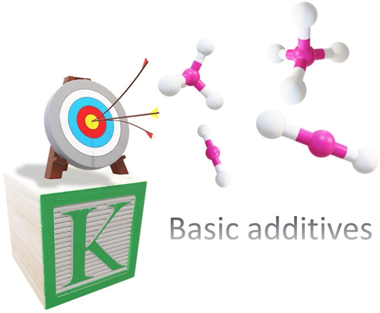
Abstract
Coke deposition is one of the key issues in the dry reforming of methane on Ni catalysts. In the present work, we investigate the effect of potassium addition for suppressing carbon deposition in the Dry Reforming of Methane. The results obtained demonstrated that potassium contents above 3 wt% promote carbon gasification, favouring both Reverse Water Gas Shift and Boudouard reaction. Strong basic Mg-O-K sites are responsible for these reactions allowing the suppression of carbon deposits and allowing the stability of the catalyst.
October, 2021 · DOI: 10.1016/j.jcou.2021.101681
Fotocatálisis Heterogénea: Aplicaciones
Photocatalytic Treatment of Stained Wastewater Coming from Handicraft Factories. A Case Study at the Pilot Plant Level
Murcia Mesa, JJ; Hernández Niño, JS; González, W; Rojas, H; Hidalgo, MC; Navío, JAWater, 13 (2021) 2705 DOI: 10.3390/w13192705
Abstract
UV/H2O2 process and TiO2-based photocatalysis were studied in the present work. The effectiveness of these methods was tested in the treatment of effluents taken from handicraft factories. Microorganisms, dyes, and different organic pollutants were detected in the industrial effluents. The experimental procedure for the wastewater treatment was carried out in a patented sunlight reactor on a pilot plant scale. From this study, UV/H2O2 was found to be the best treatment for dye elimination. The optimal peroxide dosage for the degradation of dyes and the elimination of bacteria was 0.07 M. In this case, 70.80% of discoloration was achieved after 7 h of sunlight exposure, under an average sunlight intensity of 3.42 W/m2. The photocatalytic treatment based on TiO2 achieved the highest elimination of coliform bacteria and the lowest TOC value; however, the presence of this material in the reactor had a detrimental effect on the overall elimination of dyes. A combination of both UV/H2O2 and TiO2 treatments significantly improves the dyes discoloration, the elimination of bacteria, and the organic compounds degradation. Some of the results of this study were presented at the 4th Congreso Colombiano de Procesos Avanzados de Oxidación, 4CCPAOx.
October, 2021 · DOI: 10.3390/w13192705
Fotocatálisis Heterogénea: Aplicaciones
Development of a novel PANI@WO3 hybrid composite and its application as a promising adsorbent for Cr(VI) ions removal
Abdelghani Hsinia, Yassine Naciri, Mohamed Laabd, Asmae Bouziani, J.A.Navío, F.Puga, Rabah Boukherroub, Rajae Lakhmiri, Abdallah AlbourineJournal of Environmental Chemical Engineering, 9 (2021) 105885 DOI: 10.1016/j.jece.2021.105885

Abstract
In the current study, an in-situ oxidative polymerization method was used to synthesize polyaniline-coated tungsten trioxide biphasic composite (PANI@WO3). The as-developed composite material properties were elucidated using different characterization tools such as X-ray diffraction (XRD), scanning electron microscopy (SEM), energy dispersive X-ray spectroscopy (EDX), transmission electron microscopy (TEM), Fourier transform infrared spectroscopy (FTIR), N2 sorption-desorption isotherm, and X-ray photoelectron spectroscopy (XPS). The PANI@WO3 was further applied to remove hexavalent chromium (Cr(VI)) from aqueous solutions. The results demonstrated that the optimal removal efficacy was achieved at pH 2. Meanwhile, the pseudo-second-order kinetic and isotherm of the Langmuir model were fitted for Cr(VI) adsorption. Cr(VI) amount of 549.37 mg·g−1 was the maximum capacity of adsorption attained for PANI@WO3, which is significantly higher than that of existing adsorbents. From a thermodynamic point of view, the Cr(VI) adsorption process occurred spontaneously and endothermically. Importantly, PANI@WO3 still exhibited an excellent adsorption capability after five regeneration cycles, indicating the potential reusability of the PANI@WO3 composite. XPS analysis of PANI@WO3 surface after adsorption of Cr(VI) confirmed its adsorption and concomitant reduction into Cr(III) ions. The transfer of mass phenomenon, electrostatic attraction, and reduction reaction were the primary processes for Cr(VI) ions elimination. These findings revealed that the synthesized PANI@WO3 exhibited a high potential for wastewater treatment containing Cr(VI).
October, 2021 · DOI: 10.1016/j.jece.2021.105885
Nanotecnología en Superficies y Plasma
Mechanically Switchable Wetting Petal Effect in Self-Patterned Nanocolumnar Films on Poly(dimethylsiloxane)
Parra-Barranco, J; Lopez-Santos, C; Sanchez-Valencia, JR; Borras, A; Gonzalez-Elipe, AR; Barranco, ANanomaterials, 11 (2021) 2566 DOI: 10.3390/nano11102566
Abstract
Switchable mechanically induced changes in the wetting behavior of surfaces are of paramount importance for advanced microfluidic, self-cleaning and biomedical applications. In this work we show that the well-known polydimethylsiloxane (PDMS) elastomer develops self-patterning when it is coated with nanostructured TiO2 films prepared by physical vapor deposition at glancing angles and subsequently subjected to a mechanical deformation. Thus, unlike the disordered wrinkled surfaces typically created by deformation of the bare elastomer, well-ordered and aligned micro-scaled grooves form on TiO2/PDMS after the first post-deposition bending or stretching event. These regularly patterned surfaces can be reversibly modified by mechanical deformation, thereby inducing a switchable and reversible wetting petal effect and the sliding of liquid droplets. When performed in a dynamic way, this mechanical actuation produces a unique capacity of liquid droplets (water and diiodomethane) transport and tweezing, this latter through their selective capture and release depending on their volume and chemical characteristics. Scanning electron and atomic force microscopy studies of the strained samples showed that a dual-scale roughness, a parallel alignment of patterned grooves and their reversible widening upon deformation, are critical factors controlling this singular sliding behavior and the possibility to tailor their response by the appropriate manufacturing of surface structures.
October, 2021 · DOI: 10.3390/nano11102566
Reactividad de Sólidos
Relevance of Particle Size Distribution to Kinetic Analysis: The Case of Thermal Dehydroxylation of Kaolinite
Arcenegui-Troya, J;Sanchez-Jimenez, PE; Perejon, A; Perez-Maqueda, LAProcesses, 9 (2021) 1852 DOI: 10.3390/pr9101852
Abstract
Kinetic models used for the kinetic analysis of solid-state reactions assume ideal conditions that are very rarely fulfilled by real processes. One of the assumptions of these ideal models is that all sample particles have an identical size, while most real samples have an inherent particle size distribution (PSD). In this study, the influence of particle size distribution, including bimodal PSD, in kinetic analysis is investigated. Thus, it is observed that PSD can mislead the identification of the kinetic model followed by the reaction and even induce complex thermoanalytical curves that could be misinterpreted in terms of complex kinetics or intermediate species. For instance, in the case of a bimodal PSD, kinetics is affected up to the point that the process resembles a reaction driven by a multi-step mechanism. A procedure for considering the PSD in the kinetic analysis is presented and evaluated experimentally by studying the thermal dehydroxylation of kaolinite. This process, which does not fit any of the common ideal kinetic models proposed in the literature, was analyzed considering PSD influence. However, when PSD is taken into account, the process can be successfully described by a 3-D diffusion model (Jander's equation). Therefore, it is concluded that the deviations from ideal models for this dehydroxylation process could be explained in terms of PSD.
October, 2021 · DOI: 10.3390/pr9101852
Reactividad de Sólidos
Scaling-up the Calcium-Looping Process for CO2 Capture and Energy Storage
Ortiz, C; Valverde, JM; Chacartegui, R; Perez-Maqueda, LA; Gimenez-Gavarrell, PKona Powder and Particle Journal, 38 (2021) 189-209 DOI: 10.14356/kona.2021005
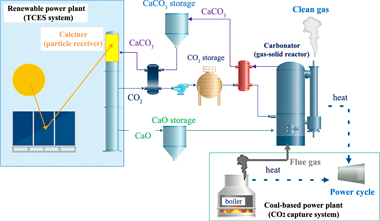
Abstract
The Calcium-Looping (CaL) process has emerged in the last years as a promising technology to face two key challenges within the future energy scenario: energy storage in renewable energy-based plants and CO2 capture from fossil fuel combustion. Based on the multicycle calcination-carbonation reaction of CaCO3 for both thermochemical energy storage and post-combustion CO2 capture applications, the operating conditions for each application may involve remarkably different characteristics regarding kinetics, heat transfer and material multicycle activity performance. The novelty and urgency of developing these applications demand an important effort to overcome serious issues, most of them related to gas-solids reactions and material handling. This work reviews the latest results from international research projects including a critical assessment of the technology needed to scale up the process. A set of equipment and methods already proved as well as those requiring further demonstration are discussed. An emphasis is put on critical equipment such as gas-solids reactors for both calcination and carbonation, power block integration, gas and solids conveying systems and auxiliary equipment for both energy storage and CO2 capture CaL applications.
October, 2021 · DOI: 10.14356/kona.2021005
Química de Superficies y Catálisis
Mesoporous Carbon Production by Nanocasting Technique Using Boehmite as a Template
Ortega-Franqueza, M; Ivanova, S; Dominguez, MI; Centeno, MACatalysts, 11 (2021) 1132 DOI: 10.3390/catal11091132

Abstract
A series of mesoporous carbonaceous materials were synthesized by the nanocasting technique using boehmite as a template and glucose as a carbon precursor. After pyrolysis and template removal, the resulting material is a mesoporous carbon that can be additionally doped with N, B and K during prepyrolysis impregnation. In addition, the influence of doping on the morphology, crystallinity and stability of the synthesized carbons was studied using X-ray diffraction, nitrogen physisorption, thermogravimetry, Raman and IR spectroscopy and transmission electron microscopy. While the nanocasting process is effective for the formation of mesopores, KOH and urea do not modify the textural properties of carbon. The use of H3PO4 as a dopant, however, led to the formation of an AlPO4 compound and resulted in a solid with a lower specific surface area and higher microporosity. All doped solids present higher thermal stability as a positive effect of the introduction of heteroatoms to the carbon skeleton. The phosphorus-doped sample has better oxidation resistance, with a combustion temperature 120-150 degrees C higher than those observed for the other materials.
September, 2021 · DOI: 10.3390/catal11091132
Tribología y Protección de Superficies
Effect of Al content on the hardness and thermal stability study of AlTiN and AlTiBN coatings deposited by HiPIMS
Mendez, A; Monclus, MA; Santiago, JA; Fernandez-Martinez, I; Rojas, TC; Garcia-Molleja, J; Avella, M; Dams, N; Panizo-Laiz, M; Molina-Aldareguia, JMSurface & Coatings Technology, 422 (2021) 127513 DOI: 10.1016/j.surfcoat.2021.127513
Abstract
The microstructure, mechanical properties and thermal stability of AT(x)Ti(1-x)N and Al1Ti1-xBN coatings grown by reactive high-power impulse magnetron sputtering (HiPIMS) have been analyzed as a function of Al/(Al + Ti) ratio (x) between 0.5 and 0.8. The coatings were predominantly formed by a face-centered cubic Ti(Al)N crystalline phase, both with and without B, even for x ratios as high as 0.6, which is higher than the ratio typically encountered for AlxTi1-xN coatings deposited by reactive magnetron sputtering. B doping, in combination with the highly energetic deposition conditions offered by HiPIMS, results in the suppression of the columnar grain morphology typically encountered in AlxTi1-xN coatings. On the contrary, the AlxTi1-xN coatings grown by HiPIMS present a dense nanocomposite type microstructure, formed by nanocrystalline Ti(Al) N domains and amorphous regions composed of Ti(Al)B 2 and BN. As a result, high-Al content (x approximate to 0.6) AlxTi1-xN coatings grown by HiPIMS offer higher hardness, elasticity and fracture toughness than AlxTi1-xN coatings. Moreover, the thermal stability and the hot hardness are substantially enhanced, delaying the onset of formation of the detrimental hexagonal AlN phase from 850 degrees C in the case of Al0.6Ti0.4N, to 1000 degrees C in the case of Al0.6Ti0.4N.
September, 2021 · DOI: 10.1016/j.surfcoat.2021.127513
Fotocatálisis Heterogénea: Aplicaciones
Photocatalytic production of hydrogen and methane from glycerol reforming over Pt/TiO2–Nb2O5
Iervolino, G; Vaiano, V; Murcia, JJ; Lara, AE; Hernández, JS; Rojas, H; Navío, JA; Hidalgo, MCInternational Journal of Hydrogen Energy DOI: 10.1016/j.ijhydene.2021.09.111
Abstract
In this study, platinized mixed oxides (TiO2–Nb2O5) were tested on photocatalytic hydrogen production from a glycerol solution under UV light. Different samples with different Ti:Nb ratios were prepared by using a simple method that simultaneously combined a physical mixture and a platinum photochemical reduction. This method led to improved physicochemical properties such as low band gap, better Pt nanoparticle distribution on the surface, and the formation of different Pt species. Niobia content was also found to be an important factor in determining the overall efficiency of the Pt–TiO2–Nb2O5 photocatalyst in the glycerol reforming reaction. The photocatalytic results showed that Pt on TiO2–Nb2O5 enhanced hydrogen production from the aqueous glycerol solution at a 5 wt% initial glycerol concentration. The influence of different operating conditions such as the catalyst dosage and initial glycerol concentration was also evaluated. The results indicated that the best hydrogen and methane production was equal to 6657 μmol/L and 194 μmol/L, respectively after 4 h of UV radiation using Pt/Ti:Nb (1:2) sample and with 3 g/L of catalyst dosage. Moreover, the role of water in photocatalytic hydrogen production was studied through photocatalytic activity tests in the presence of D2O. The obtained results confirmed the role of water molecules on the photocatalytic production of hydrogen in an aqueous glycerol solution.
September, 2021 · DOI: 10.1016/j.ijhydene.2021.09.111
Tribología y Protección de Superficies
Nb-C thin films prepared by DC-MS and HiPIMS: Synthesis, structure, and tribomechanical properties
Sala, N; Abad, MD; Sánchez-López, JC; Caro, J; Colominas, CSurface & Coatings Technology, 422 (2021) 127569 DOI: 10.1016/j.surfcoat.2021.127569

Abstract
Nanostructured Nb-C thin films were prepared by direct current magnetron sputtering (DC-MS) and high-power impulse magnetron sputtering (HiPIMS). The films were characterized in depth by X-ray diffraction (XRD), grazing incidence X-ray diffraction, scanning electron microscopy, atomic force microscopy, electron probe microanalysis, and Raman spectroscopy. The mechanical properties were measured by nanoindentation, and the tribological properties were measured by pin-on-disk tests in ambient air. The wear tracks and ball scars were analyzed by Raman spectroscopy to elucidate the tribochemical reactions that occurred at the contact area and to determine the wear mechanism for each specimen type. The thermal stability of the coatings was studied up to 1000 degrees C using Raman spectroscopy and XRD. The samples prepared by DC-MS were very dense, and the phase composition changed from purely nanocrystalline (Nb2C and NbC) to a mixture of NbC crystals embedded in an amorphous carbon-based matrix (NbC/a-C(:H)). However, the samples prepared by HiPIMS developed a marked columnar morphology with a NbC/a-C(:H) nanocomposite structure. The hardness values ranged from 11 to 20 GPa depending on the deposition technique and the amount of the soft a-C(:H) phase present in the sample. The tribological properties of all the coatings were remarkably good when the carbon content was approximately 50 at.%. The formation of a lubricating sp(2)-rich C tribofilm between the ball and coating during the pin-on-disk tests was observed by Raman spectroscopy. The tribofilm formed preferentially on the samples prepared by HiPIMS, which had higher C contents. At 750 degrees C, the degradation of the NbC phases resulted in the formation of an additional a-C phase and niobium oxides.
September, 2021 · DOI: 10.1016/j.surfcoat.2021.127569
Materiales Coloidales
Si sputtering yield amplification: a study of the collisions cascade and species in the sputtering plasma
Cruz, J; Sangines, S; Soto-Valle; Muhl; Sierra, I; De Lucio-Morales, O; Mitrani, A; Calderon-Olvera, RM; Mendoza-Perez, R; Machorro-Mejia, RJournal of Physics D-Applied Physics, 54 (2021) 375201 DOI: 10.1088/1361-6463/ac0c4e
Abstract
The sputtering yield amplification (SYA) is a phenomenon based on doping a sputtering target with atoms of higher atomic mass. This doping changes the depth and the direction of the collision cascade in the target surface promoting a higher ejection of target atoms. In this work, we present a new way of generating the SYA phenomenon without the need of expensive and complex deposition systems. This was accomplished by increasing the working pressure and adding small pieces of W, as dopant element, on the racetrack of a Si target. The physical phenomena necessary to promote the SYA, for our experimental parameters, were analysed in two different deposition chambers and two sizes of sputtering targets. Based on the collisions in the gas phase, a calculation on the number of W atoms returning to the racetrack area was made, considering the number of atoms deposited on the thin films, to determine their effect on the cascade of collisions. In addition, calculations with the simulation of metal transport code were developed to determine the location on the racetrack zone the returning atoms were redeposited. By using reference samples placed on the racetrack of the Si target, we found that the percentage of SYA depends on the number of dopant atoms redeposited as well as the depth distribution these atoms had in the racetrack surface.
September, 2021 · DOI: 10.1088/1361-6463/ac0c4e
Nanotecnología en Superficies y Plasma - Materiales Nanoestructurados y Microestructura
Pd-C Catalytic Thin Films Prepared by Magnetron Sputtering for the Decomposition of Formic Acid
Arzac, GM; Fernandez, A; Godinho, V; Hufschmidt, D; de Haro, MCJ; Medran, B; Montes, ONanomaterials, 11 (2021) 2326 DOI: 10.3390/nano11092326
Abstract
Formic acid is an advantageous liquid organic hydrogen carrier. It is relatively nontoxic and can be synthesized by the reaction of CO2 with sustainable hydrogen or by biomass decomposition. As an alternative to more widely studied powdery catalysts, supported Pd-C catalytic thin films with controlled nanostructure and compositions were newly prepared in this work by magnetron sputtering on structured supports and tested for the formic acid decomposition reaction. A two-magnetron configuration (carbon and tailored Pd-C targets) was used to achieve a reduction in Pd consumption and high catalyst surface roughness and dispersion by increasing the carbon content. Activity and durability tests were carried out for the gas phase formic acid decomposition reaction on SiC foam monoliths coated with the Pd-C films and the effects of column width, surface roughness and thermal pre-reduction time were investigated. Activity of 5.04 mol(H2)center dot g(Pd)(-1)center dot h(-1) and 92% selectivity to the dehydrogenation reaction were achieved at 300 degrees C for the catalyst with a lower column width and higher carbon content and surface roughness. It was also found that deactivation occurs when Pd is sintered due to the elimination of carbon and/or the segregation and agglomeration of Pd upon cycling. Magnetron sputtering deposition appears as a promising and scalable route for the one-step preparation of Pd-C catalytic films by overcoming the different deposition characteristics of Pd and C with an appropriate experimental design.
September, 2021 · DOI: 10.3390/nano11092326
Materiales y Procesos Catalíticos de Interés Ambiental y Energético
Examination of the Deactivation Cycle of NiAl- and NiMgAl-Hydrotalcite Derived Catalysts in the Dry Reforming of Methane
Abdelsadek, Z.; Holgado, J.P.; Halliche, D.; Caballero, A.; Cherifi, O.; Gonzalez-Cortes, S.; Masset, P.J.Catalysis Letters, 151 (2021) 2696-2715 DOI: 10.1007/s10562-020-03513-4

Abstract
The importance of the dry reforming of methane (DRM) lies in its capability to upgrade two greenhouse gases (CH4 and CO2) into synthesis gas (CO and H-2), which is one of the main building block for synthesizing hydrocarbons. However, the Ni-based catalysts for DRM reaction usually have a major catalytic stability drawback. This works aims to assess the catalytic activity and stability of two Ni-based catalysts obtained from hydrotalcite (HT) precursors (i.e., NiAl-HT and NiMgAl-HT). The precursors, calcined (-c), reduced (-R) and spent samples were characterized by a series of techniques to gain insight into the influence of MgO over Ni-based catalyst in the drying reforming of methane. An in-situ ageing cycle process to speed up the deactivation of hydrotalcite-derived catalysts showed that the NiMgAl-HTc-R catalyst displayed a higher activity and resistance to coke formation (stability) than NiAl-HTc-R because of the introduction of Mg into hydrotalcite structure in the catalyst precursor. The presence of this element enhances several factors involved in the stability of Ni-based catalysts for the DRM process such as the reducibility and textural features of the catalysts, size and dispersion of Ni-0 nanoparticles and also maintains a good compromise between the acid and base properties of the solid catalysts.
September, 2021 · DOI: 10.1007/s10562-020-03513-4
Química de Superficies y Catálisis
Structure-sensitivity of formic acid dehydrogenation reaction over additive-free Pd NPs supported on activated carbon
Santos, J.L.; Megías-Sayago, C.; Ivanova, S.; Centeno, M.A.; Odriozola, J.A.Chemical Engineering Journal, 420 (2021) 127641 DOI: 10.1016/j.cej.2020.127641
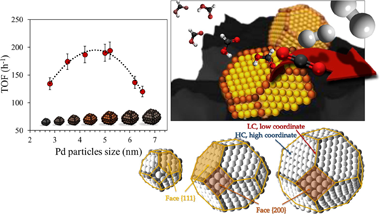
Abstract
In this study the size-activity dependence of palladium based catalysts in formic acid dehydrogenation reaction was investigated and evaluated. A wide range of particle sizes was considered and the catalyst series were prepared upon variation of some synthetic parameters, precursor and solvent nature in particular. Synthesis method variations affect significantly Pd particle size and results in diverse activity toward hydrogen production. An optimal size was observed and explained by the diverse proportion of low and high coordinated Pd states available for different samples within the series. The evaluation of particles much bigger than 6 nm changes importantly the fraction of high and low coordination atoms and allows the clear confirmation of the importance of the presence of low coordination atoms on the surface of catalyst.
September, 2021 · DOI: 10.1016/j.cej.2020.127641
Materiales Ópticos Multifuncionales - Materiales Coloidales
Persistent luminescent nanoparticles: Challenges and opportunities for a shimmering future
Castaing, V.; Arroyo, E.; Becerro, A.I.; Ocaña, M.; Lozano, G.; Míguez, H.Journal of Applied Physics, 130 (2021) 080902 DOI: 10.1063/5.0053283
Abstract
Persistent phosphors are luminescent sources based on crystalline materials doped with rare-earth or transition metal cations able to produce light after the excitation source vanishes. Although known for centuries, these materials gained renewed interest after the discovery of Eu2+,RE3+ co-doped aluminates and silicates in the late 1990s due to their unprecedented afterglow properties. In contrast, persistent nanophosphors have emerged only recently as a nanoscale alternative to their bulk counterparts, offering exciting opportunities of particular relevance for in vivo imaging, optical data storage, or unconventional light generation. However, taking advantage of the avenues opened by nanoscience demands developing new synthetic strategies that allow precise control of the morphology, surface, and defect chemistry of the nanomaterials, along with a profound understanding of the physical mechanisms occurring in the nanoscale. Besides, advanced physicochemical characterization is required to assess persistent luminescence in a quantitative manner, which allows strict comparison among different persistent nanophosphors, aiming to propel their applicability. Herein, we revisit the main phenomena that determine the emission properties of persistent nanoparticles, discuss the most promising preparation and characterization protocols, highlight recent achievements, and elaborate on the challenges ahead.
August, 2021 · DOI: 10.1063/5.0053283
Reactividad de Sólidos
Study of the Influence of Sintering Atmosphere and Mechanical Activation on the Synthesis of Bulk Ti2AlN MAX Phase Obtained by Spark Plasma Sintering
Salvo, C; Chicardi, E; García-Garrido, C; Poyato, R; Jimenez, JA; Mangalaraja, RVMaterials, 14 (2021) 4574 DOI: 10.3390/ma14164574
Abstract
The influence of the mechanical activation process and sintering atmosphere on the microstructure and mechanical properties of bulk Ti2AlN has been investigated. The mixture of Ti and AlN powders was prepared in a 1:2 molar ratio, and a part of this powder mixture was subjected to a mechanical activation process under an argon atmosphere for 10 h using agate jars and balls as milling media. Then, the sintering and production of the Ti2AlN MAX phase were carried out by Spark Plasma Sintering under 30 MPa with vacuum or nitrogen atmospheres and at 1200 degrees C for 10 min. The crystal structure and microstructure of consolidated samples were characterized by X-ray Diffraction, Scanning Electron Microscopy, and Energy Dispersive X-ray Spectroscopy. The X-ray diffraction patterns were fitted using the Rietveld refinement for phase quantification and determined their most critical microstructural parameters. It was determined that by using nitrogen as a sintering atmosphere, Ti4AlN3 MAX phase and TiN were increased at the expense of the Ti2AlN. In the samples prepared from the activated powders, secondary phases like Ti5Si3 and Al2O3 were formed. However, the higher densification level presented in the sample produced by using both nitrogen atmosphere and MAP powder mixture is remarkable. Moreover, the high-purity Ti2AlN zone of the MAX-1200 presented a hardness of 4.3 GPa, and the rest of the samples exhibited slightly smaller hardness values (4.1, 4.0, and 4.2 GPa, respectively) which are matched with the higher porosity observed on the SEM images.
August, 2021 · DOI: 10.3390/ma14164574
Reactividad de Sólidos
Kinetics and cyclability of limestone (CaCO3) in presence of steam during calcination in the CaL scheme for thermochemical energy storage
Arcenegui-Troya, J; Sanchez-Jimenez, PE; Perejon, A; Moreno, V; Valverde, JM; Perez-Maqueda, LAChemical Engineering Journal, 417 (2021) 129194 DOI: 10.1016/j.cej.2021.129194
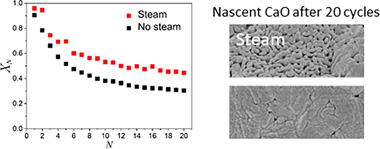
Abstract
In the present work, we explore the use of steam in the CaCO3 calcination step of the Calcium Looping process devised for thermochemical energy storage (CaL-TCES). Steam produces a double benefit: firstly, it fastens calcination, allowing a reduction of the temperature needed to attain full calcination in short residence times, as those required in practice, resulting in energy savings. This behaviour is justified on the basis of a kinetics study results obtained from a non-parametric kinetic analysis, which demonstrate that the presence of steam during calcination can reduce the apparent activation energy from 175 kJ/mol to 142 kJ/mol with a steam's partial pressure of 29%. In addition, the results obtained for multicycle CaL-TCES tests show that steam alleviates the deactivation of the sorbent, which is one of the main limiting factors of this technology. This behaviour is explained in terms of the effect of steam on the microstructure of the regenerated CaO. Importantly, the values of residual conversion attained by calcining in steam are higher than those without steam.
August, 2021 · DOI: 10.1016/j.cej.2021.129194
Materiales Avanzados
Geopolymers made from metakaolin sources, partially replaced by Spanish clays and biomass bottom ash
Eliche-Quesada, D; Calero-Rodriguez, A; Bonet-Martinez, E;Perez-Villarejo, L; Sanchez-Soto, PJJournal of Building Engineering, 40 (2021) 102761 DOI: 10.1016/j.jobe.2021.102761
Abstract
The main objective of this investigation is to study the effect of the substitution of metakaolin (MK) (from calcined industrial kaolin) by four different calcined natural Southern Spain clays traditionally used in the brick and tile sector, as well as by the biomass bottom ash residue (BBA) from the combustion of a mix of olive and pine pruning on the synthesis of geopolymer with physical, mechanical and thermal properties comparable to those of classic construction materials. As alkaline activator, a 8 M solution of sodium hydroxide and sodium silicate have been used. Raw materials, metakaolin; Spanish clays: black clay (BC), yellow clay (YC), white clay (WC), red clay (RC) and BBA were characterized by chemical analysis (XRF), mineralogical analysis (XRD), and particle size analysis. Control geopolymers containing only metakaolin, and batch of geopolymers were formulated containing equal proportions of metakaolin, BBA and each of the four types of clay. After the curing period, at 60 degrees C for 1 day geopolymers were demolded and stored 27 days at room temperature. Geopolymers were characterized using Scanning Electron Microscopy coupled with Energy Dispersive Spectroscopy (SEM-EDS), XRD and Attenuated Total Reflectance-Fourier Transform Infrared Spec troscopy (ATR-FTIR). Their physical, mechanical and thermal properties have also been studied. The addition of BBA and different types of calcined clays to metakaolin gives rise to geopolymers with higher mechanical properties increasing the compressive strength of the control geopolymer containing only MK (24.9 MPa) by more than 50% for the GMK-BBA-WC geopolymers (38.5 MP a). The clays act as fillers and/or promote the precipitation of calcium-rich phases (Ca)-A-S-H-G gel that coexists with the (Na)-A-S-H gel type. The relevant results of physical, mechanical and thermal properties obtained in this research demonstrate the potential of Spanish clays and BBA as binders and substitutes for metakaolin.
August, 2021 · DOI: 10.1016/j.jobe.2021.102761
Reactividad de Sólidos
Calcination under low CO2 pressure enhances the calcium Looping performance of limestone for thermochemical energy storage
Sarrion, B; Perejon, A; Sanchez-Jimenez, PE; Amghar, N; Chacartegui, R; Valverde, JM; Perez-Maqueda, LAChemical Engineering Journal, 417 (2021) 127922 DOI: 10.1016/j.cej.2020.127922
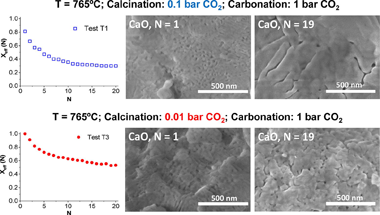
Abstract
The Calcium Looping performance of limestone for thermochemical energy storage has been investigated under novel favorable conditions, which involve calcination at moderate temperatures under CO2 at low pressure (0.01 and 0.1 bar) and carbonation at high temperature under CO2 at atmospheric pressure. Calcining at low CO2 pressures allows to substantially reduce the temperature to achieve full calcination in short residence times. Moreover, it notably enhances CaO multicycle conversion. The highest values of conversion are obtained for limestone samples calcined under 0.01 bar CO2 at 765 degrees C. Under these conditions, the residual conversion is increased by a factor of 10 as compared to conditions involving calcination under CO2 at atmospheric pressure. The enhancement of CaO conversion is correlated to the microstructure of the CaO samples obtained after calcination. As seen from SEM, BET surface and XRD analysis, calcination under low CO2 pressure leads to a remarkable decrease of pore volume and CaO crystallite size. Consequently, CaO surface area available for carbonation in the fast reaction-controlled regime and therefore reactivity in short residence times is promoted.
August, 2021 · DOI: 10.1016/j.cej.2020.127922
Reactividad de Sólidos
Mechanochemical synthesis of ternary chalcogenide chalcostibite CuSbS2 and its characterization
Dutkova, E; Sayagues, MJ; Fabian, M; Kovac, J; Kovat, J; Balaz, M; Stahorsky, MJournal of Materials Science-Materials in Electronics (2021) DOI: 10.1007/s10854-021-06767-9
Abstract
In this work, the very rapid one-step mechanochemical synthesis of nanocrystalline ternary chalcogenide chalcostibite CuSbS2 prepared from copper, antimony, and sulfur precursors by high-energy milling for only 30 min in a planetary mill is reported. XRD confirmed the orthorhombic crystal structure of CuSbS2. The crystallite size of CuSbS2 calculated by LeBail refinement of the X-ray powder diffraction data was 25 nm. The nanocrystalline chalcostibite CuSbS2 was also confirmed by transmission electron microscopy. The purity of CuSbS2 was verified by Raman spectroscopy. The synthesized chalcostibite exhibits the specific surface area value of 2.4 m(2)g(-1). UV-Vis spectroscopy showed the optical bandgap of CuSbS2 as 1.54 eV with wide range of absorption in visible region. Photoresponse of CuSbS2 was confirmed by I-V measurements under dark and light illumination. The proposed mechanochemical synthesis provides an alternative approach to prepare also other ternary semiconductor nanomaterials. CuSbS2 semiconductor nanocrystals have the potential to be used as light absorbers in photovoltaics.
August, 2021 · DOI: 10.1007/s10854-021-06767-9
Nanotecnología en Superficies y Plasma
Factors triggering germination in plasma-activated cotton seeds: water imbibition vs. reactive species' formation
Arroyo, E; De Navascues, P; Gómez-Ramírez, A; Molina, R; Perea, A; García, JL; Cotrino, J ; Cantos, M; González-Elipe, AR; López-Santos, CJournal of Physics D-Applied Physics, 54 (2021) 325205 DOI: 10.1088/1361-6463/abfefc
Abstract
Plasma technology has emerged as an efficient, simple, and eco-friendly method for activating seed germination processes. Most studies on this subject have focused on the morphological and wetting effects on the surface state of seeds and attributed the improvement in germination occasionally found to the induced hydrophilicity and a higher water imbibition rate. Recently, the involvement of reactive oxygen and nitrogen species in the germination process has also been highlighted. In this work, we study the effect of a very low-power cold atmospheric air-plasma treatment on the germination and sterilization of cotton seeds in normal (i.e., water abundant) and simulated drought conditions. Optical emission spectroscopy of the plasma has revealed the formation of different excited species of molecular nitrogen and oxygen, as well as OH and NO radicals that are deemed responsible for the chemical functionalization and slight morphological changes observed on the surfaces of cotton seeds. The physicochemical changes of the seed surface were analyzed by scanning electron microscopy, energy-dispersive x-ray spectroscopy, Fourier-transform infrared spectroscopy (FT-IR), and x-ray photoemission spectroscopy. This latter technique has shown the formation of a high surface concentration of oxygenated (i.e. -CO (x) , -C-OH, -O (x) ) and oxinitrided (i.e. -NO (x) ) functional groups which disappear from the surface upon exposure to vapor or liquid water. This process must entail the diffusion of these species (together with that of potassium ions that were plasma segregated to the surface) into the interior of seeds. The fact that the water uptake capacity of seeds is not significantly modified by the plasma treatment suggests that the observed in-diffusion of active oxygen and nitrogen species is an important factor in the enhancement of germination capacity induced by plasma activation, particularly under conditions of water scarcity, where germination differences of more than 60% could be found between pristine and plasma-treated seeds. The analysis by FT-IR of the adsorption of deuterated water (D2O) molecules is proposed as a useful procedure to directly monitor water uptake/release processes from seed surfaces.
August, 2021 · DOI: 10.1088/1361-6463/abfefc
Nanotecnología en Superficies y Plasma - Materiales Ópticos Multifuncionales
One-reactor vacuum and plasma synthesis of transparent conducting oxide nanotubes and nanotrees: from single wire conductivity to ultra-broadband perfect absorbers in the NIR
Castillo-Seoane, J; Gil-Rostra, J; Lopez-Flores, V; Lozano, G; Ferrer, FJ; Espinos, JP; Ostrikov, K; Yubero, F; Gonzalez-Elipe, AR; Barranco, A; Sanchez-Valencia, JR; Borras, ANanoscale, 13 (2021) 13882-13895 DOI: 10.1039/d1nr01937f
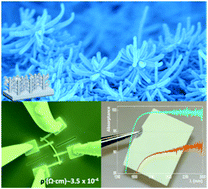
Abstract
The eventual exploitation of one-dimensional nanomaterials needs the development of scalable, high yield, homogeneous and environmentally friendly methods capable of meeting the requirements for fabrication of functional nanomaterials with properties on demand. In this article, we demonstrate a vacuum and plasma one-reactor approach for the synthesis of fundamental common elements in solar energy and optoelectronics, i.e. the transparent conducting electrode but in the form of nanotube and nanotree architectures. Although the process is generic and can be used for a variety of TCOs and wide-bandgap semiconductors, we focus herein on indium doped tin oxide (ITO) as the most previously researched in previous applications. This protocol combines widely applied deposition techniques such as thermal evaporation for the formation of organic nanowires serving as 1D and 3D soft templates, deposition of polycrystalline layers by magnetron sputtering, and removal of the templates by simply annealing under mild vacuum conditions. The process variables are tuned to control the stoichiometry, morphology, and alignment of the ITO nanotubes and nanotrees. Four-probe characterization reveals the improved lateral connectivity of the ITO nanotrees and applied on individual nanotubes shows resistivities as low as 3.5 +/- 0.9 x 10(-4) omega cm, a value comparable to that of single-crystalline counterparts. The assessment of diffuse reflectance and transmittance in the UV-Vis range confirms the viability of the supported ITO nanotubes as random optical media working as strong scattering layers. Their further ability to form ITO nanotrees opens a path for practical applications as ultra-broadband absorbers in the NIR. The demonstrated low resistivity and optical properties of these ITO nanostructures open a way for their use in LEDs, IR shields, energy harvesting, nanosensors, and photoelectrochemical applications.
August, 2021 · DOI: 10.1039/d1nr01937f
Nanotecnología en Superficies y Plasma
Laser-induced scanning transfer deposition of silver electrodes on glass surfaces: A green and scalable technology
Molina, R; Ertugrul, M; Larrea, A; Navarro, R; Rico, V; Yubero, F; Gonzalez-Elipe, AR: De la Fuente, GF; Angurel, LAApplied Surface Science, 556 (2021) 149673 DOI: 10.1016/j.apsusc.2021.149673

Abstract
A pulsed laser ablation backwriting technique with high repetitive rates is implemented for the fabrication of silver coatings on glass surfaces. This method enables geometrical constraint-free deposition of metallic coatings. These exhibit sufficiently low electrical resistance to be used as electrodes in dielectric barrier discharge (DBD) plasma elements. Ambient air deposition of metallic silver electrodes on standard glass slides is explored using a sub-ns UV laser source, combined with hybrid beam scanning methods. The green nature of the overall deposition process includes a preliminary irradiation scan to homogenise the target surface before the subsequent backwriting step. Metal transfer is achieved by combining two phenomena within a simple beam scanning process: LIRT (laserinduced reverse transfer) of silver from the target to the glass, with a partial and secondary LIFT (Laser-Induced Forward Transfer) of silver from the glass to the target. Appropriate selection of pulse energy and pulse repetition rates, beam scanning velocities and target motion enable the growth of sufficiently thick Ag deposits on glass with the required low electrical resistivity and nearly 2D constraint-free geometry. This method avoids the use of vacuum and liquids, resulting in a cheap, facile and green methodology for the deposition of silver electrodes onto transparent substrate surfaces.
August, 2021 · DOI: 10.1016/j.apsusc.2021.149673
Fotocatálisis Heterogénea: Aplicaciones
ZnO/Ag3PO4 and ZnO–Malachite as Effective Photocatalysts for the Removal of Enteropathogenic Bacteria, Dyestuffs, and Heavy Metals from Municipal and Industrial Wastewater
Murcia, JJ; Hernández Miño, JS; Rojas, H; Brijaldo, MH; Martin-Gómez, AN; Sánchez-Cid, P; Navío, JA; Hidalgo, MC; Jaramillo-Pérez, CWater, 13 (2021) 2264 DOI: 10.3390/w13162264

Abstract
Different composites based on ZnO/Ag3PO4 and ZnO–malachite (Cu2(OH)2CO3) were synthesized in order to determine their effectiveness in the treatment of municipal and industrial wastewaters (mainly polluted by enteropathogenic bacteria, dyes, and heavy metals). The addition of Ag3PO4 and malachite did not significantly modify the physicochemical properties of ZnO; however, the optical properties of this oxide were modified as a result of its coupling with the modifiers. The modification of ZnO led to an improvement in its effectiveness in the treatment of municipal and industrial wastewater. In general, the amount of malachite or silver phosphate and the effluent to be treated were the determining factors in the effectiveness of the wastewater treatment. The highest degree of elimination of bacteria from municipal wastewater and discoloration of textile staining wastewater were achieved by using ZnO/Ag3PO4 (5%), but an increase in the phosphate content had a detrimental effect on the treatment. Likewise, the highest Fe and Cu photoreduction from coal mining wastewater was observed by using ZnO–malachite (2.5%) and ZnO/Ag3PO4 (10%), respectively. Some of the results of this work were presented at the fourth Congreso Colombiano de Procesos Avanzados de Oxidación (4CCPAOx).
August, 2021 · DOI: 10.3390/w13162264
Materiales Ópticos Multifuncionales
Light-Harvesting Properties of a Subphthalocyanine Solar Absorber Coupled to an Optical Cavity
Esteso, V; Calio, L; Espinos, H; Lavarda, G; Torres, T; Feist, J; Garcia-Vidal, FJ; Bottari, G; Míguez, HSOLAR RRL, (2021) 2100308 DOI: 10.1002/solr.202100308
Abstract
Herein, both from the experimental and theoretical point of view, the optical absorption properties of a subphthalocyanine (SubPc), an organic macrocycle commonly used as a sunlight harvester, coupled to metallic optical cavities are analyzed. How different electronic transitions characteristic of this compound and specifically those that give rise to excitonic (Q band) and charge transfer (CT band) transitions couple to optical cavity modes is investigated. It is observed that whereas the CT band couples weakly to the cavity, the Q band transitions show evidence of hybridization with the photon eigenstates of the resonator, a distinctive trait of the strong coupling regime. As a result of the different coupling regimes of the two electronic transitions, very different spectral and directional light-harvesting features are observed, which for the weakly coupled CT transitions are mainly determined by the highly dispersive cavity modes and for the strongly coupled Q band by the less angle-dependent exciton-polariton bands. Modeling also allows discriminating parasitic from productive absorption in each case, enabling the estimation of the expected losses in a solar cell acting as an optical resonator.
July, 2021 · DOI: 10.1002/solr.202100308
Materiales y Procesos Catalíticos de Interés Ambiental y Energético
Mechanistic Considerations on the H-2 Production by Methanol Thermal-assisted Photocatalytic Reforming over Cu/TiO2 Catalyst
Platero, F; Lopez-Martin, A; Caballero, A; Colon, GCHEMCATCHEM, 13 (2021) 3878-3888 DOI: 10.1002/cctc.202100680
Abstract
We have studied the gas phase H-2 production by methanol thermo-photoreforming using Cu-modified TiO2. Metal co-catalyst has been deposited by means of photodeposition method. The concentration of methanol in the steam was also considered. It appears that H-2 production is notably higher as temperature increases. Moreover, the optimum H-2 yield is achieved using methanol concentration of 10 % v/v. CO and CO2 were monitored as side products of the overall reaction. It has been stated that CO evolution is significant at lower temperatures. As temperature increases, CO evolution is hindered and H-2 appeared boosted. We have demonstrated that other reactions such water-gas-shift or formate dehydration would participate in the overall process. On this basis, optimal operational condition for H-2 production is attained for thermo-photocatalytic reforming of methanol solution 10 % v/v at 200 degrees C.
July, 2021 · DOI: 10.1002/cctc.202100680
Química de Superficies y Catálisis
Bimetallic Ni-Ru and Ni-Re Catalysts for Dry Reforming of Methane: Understanding the Synergies of the Selected Promoters
Moreno, AA; Ramirez-Reina, T; Ivanova, S; Roger, AC; Centeno, MA; Odriozola, JAFrontiers in Chemistry, 9 (2021) 694976 DOI: 10.3389/fchem.2021.694976
Abstract
Designing an economically viable catalyst that maintains high catalytic activity and stability is the key to unlock dry reforming of methane (DRM) as a primary strategy for biogas valorization. Ni/Al2O3 catalysts have been widely used for this purpose; however, several modifications have been reported in the last years in order to prevent coke deposition and deactivation of the samples. Modification of the acidity of the support and the addition of noble metal promoters are between the most reported strategies. Nevertheless, in the task of designing an active and stable catalyst for DRM, the selection of an appropriate noble metal promoter is turning more challenging owing to the lack of homogeneity of the different studies. Therefore, this research aims to compare Ru (0.50 and 2.0%) and Re (0.50 and 2.0%) as noble metal promoters for a Ni/MgAl2O4 catalyst under the same synthesis and reaction conditions. Catalysts were characterized by XRF, BET, XRD, TPR, hydrogen chemisorption (H2-TPD), and dry reforming reaction tests. Results show that both promoters increase Ni reducibility and dispersion. However, Ru seems a better promoter for DRM since 0.50% of Ru increases the catalytic activity in 10% and leads to less coke deposition.
July, 2021 · DOI: 10.3389/fchem.2021.694976
Materiales Ópticos Multifuncionales
Ligand-Free MAPbI(3) Quantum Dot Solar Cells Based on Nanostructured Insulating Matrices
Rubino, A; Calio, L; Calvo, ME; Miguez, HSOLAR RRL (2021) 2100204 DOI: 10.1002/solr.202100204
Abstract
The stability, either chemical or thermal, and performance of colloidal quantum dot (CQD) devices are typically limited by the presence of surface-bonded organic ligands required to stabilize the nanocrystals. In addition, optimization of charge transport implies lengthy ligand exchange processing. Herein, evidence of efficient charge transport through a network of ligand-free perovskite quantum dots (PQDs) embedded in an insulating porous matrix made of monodisperse SiO2 nanoparticles is shown. Methylammonium lead iodide (CH3NH3PbI3 or MAPbI(3)) QDs are prepared in situ by infiltration of precursors within the matrix pores, which act both as nanoreactors for the synthetic reaction and as supporting scaffolds, hence reducing the number of synthetic and postprocessing steps usually required in CQD solar cells. Above a certain nanocrystal load, charge percolation is reached and dot-to-dot transport achieved without compromising quantum confinement effects. Solar cells based on MAPbI(3) QDs prepared in this way present a 9.3% efficiency, the highest reported for a scaffold-supported PQD solar cell, and significantly improved stability under solar illumination with respect to their bulk counterparts. Therefore, adequately designed networks of ligand-free PQDs can be used as both light harvesters and photocarrier conductors, in an alternative configuration to that used in previously developed QD solar cells.
July, 2021 · DOI: 10.1002/solr.202100204
Química de Superficies y Catálisis
Current scenario and prospects in manufacture strategies for glass, quartz, polymers and metallic microreactors: A comprehensive review
Dominguez, MI; Centeno, MA; Martinez, TM; Bobadilla, LF; Laguna, OH; Odriozola, JAChemical Engineering Research & Design, 171 (2021) 13-35 DOI: 10.1016/j.cherd.2021.05.001

Abstract
One of the most remarkable benefits of the microreactors is the achievement of more efficient processes by enhancing the heat and mass transfer phenomena, which is the key factor for processes intensification in chemical reactions, resulting in higher conversion, selectivity and yield towards desired products. Currently, the entire scenario of microreaction approach is an emergent technology and further advances are ongoing. Several strategies have been successfully applied for structuring processes that imply the fixation of the catalysts on the microreactors. However, there are features such as the physicochemical stability of the coatings under reaction conditions that must be improved, motivating the search for new protocols. This review provides a general overview of the most important methodologies applied for glass, quartz, polymers and metals microreactors manufacture and for their coating, analyzing the advantages and drawbacks of every procedure. Furthermore, an outline of the novel insights based on additive manufacturing techniques are described.
July, 2021 · DOI: 10.1016/j.cherd.2021.05.001
Nanotecnología en Superficies y Plasma
Characterizing the physicochemical and mechanical properties of ZrN thin films deposited on Zr substrates by pulsed laser technique
Ghemras, I; Abdelli-Messaci, S; Alili, B; Gonzalez-Elipe, AR; Rico, VJ; Izerrouken, M; Khereddine, AY; Hadj-Larbi, FEuropean Physical Journal-Applied Physics, 95 (2021) 10301 DOI: 10.1051/epjap/2021210064
Abstract
Due to their outstanding physical and mechanical features, ZrN thin films are increasingly used as coatings to protect materials intended for nuclear applications such as Zirconium. To our knowledge, there is no report of pulsed laser deposition (PLD) of ZrN thin films on a Zr substrate. In this work, we have successfully prepared ZrN thin films on Zr substrates using the PLD technique with a KrF excimer laser, in a N-2 environment at 2 Pa pressure and a fixed substrate temperature of 500 degrees C. The deposited 200 nm ZrN thin films exhibited a homogeneous surface and showed a face-centered cubic polycrystalline structure. The surface roughness was 3.69 nm. X-ray diffraction, Raman and X-ray photoelectron spectroscopy measurements confirmed the presence of ZrN. The coated sample's mean value of hardness (11.6 GP) doubled that of the uncoated sample.
July, 2021 · DOI: 10.1051/epjap/2021210064
Química de Superficies y Catálisis
How a small modification in the imidazolium-based SDA can determine the zeolite structure? MFI vs. TON
Megias-Sayago, C; Blanes, JMM; Szyja, BM; Odriozola, JA; Ivanova, SMicroporous and Mesoporous Materials, 322 (2021) 111160 DOI: 10.1016/j.micromeso.2021.111160

Abstract
The present study proposes an important contribution to the understanding of ionic liquid role as structure directing agent for zeolite synthesis. A series of imidazolium based ionic liquids are used for this purpose. While the anionic counterpart influences the micellar organization during the synthesis, the imidazolium cation clearly directs the structure to one or another zeolite family as a function of its substituents and their interaction with the zeolite framework. The experimental observations are contrasted with molecular modeling explaining the distinct zeolite families obtained on the basis of different preferential orientation of the ionic liquids to the Si33 precursor.
July, 2021 · DOI: 10.1016/j.micromeso.2021.111160
Reactividad de Sólidos
Tuning the excitation wavelength of luminescent Mn2+-doped ZnSxSe1-x obtained by mechanically induced self-sustaining reaction
Aviles, MA; Gotor, FJOptical Materials, 117 (2021) 111121 DOI: 10.1016/j.optmat.2021.111121
Abstract
Mn2+-doped ZnSxSe1-x solid solution samples (Mn:ZnSxSe1-x) were synthesized by the mechanochemical process denoted as mechanically-induced self-sustaining reaction from Mn/Zn/S/Se powder elemental mixtures. The samples were characterized by X-ray diffraction, scanning electron microscopy, diffuse reflectance UV-Vis spectroscopy and emission and excitation photoluminescence measurements. The band-gap energy of samples was controlled by changing the stoichiometry, x, of the solid solution. All samples showed the characteristic Mn2+ 4T1-6A1 emission at -588 nm when exciting the host material, so it was possible to tune the excitation wavelength from 349 nm to 467 nm. However, an efficiency loss was observed with increasing Se content, probably due to the overlap between the absorption and emission spectra that induced self-absorption and emission quenching.
July, 2021 · DOI: 10.1016/j.optmat.2021.111121
Archeometric characterization (physical-chemical and microstructural) of tiles in the Mudejar Palace of the Royal Alcazar of Seville using non-invasive quantitative chemical methods
Perez-Rodriguez, JL; Robador, MD; Castaing, J; de Viguerie, L; Garrote, MA; Pleguezuelo, ABoletin de la Sociedad Española de Ceramica y Vidrio, 60 (2021) 211-228 DOI: 10.1016/j.bsecv.2020.03.001
Abstract
The Palaces in the Alcazar of Seville, Spain, are famous for their ceramic decoration. The technique of tessellation was used extensively in all rooms in the Mudejar Palace, dated in the fourteenth century. These glazed ceramics have been analysed in situ using noninvasive quantitative chemical methods of X-ray fluorescence and diffraction (XRF and XRD). Micro-samples were taken to prepare cross-sections and analysed by optical and electronic microscopy. The composition of these ceramics, their manufacturing technique and the time of application in the different areas of the Palace have been characterized in this work. Five colours have been found in the glazed ceramics: green, black, molasses, white and blue. Fe, Co, Cu, Mn and Sn are the main chemical elements responsible for the colour of the glass phase of these ceramics. Wollastonite, quartz, bustamite and feldspars inclusions have been found in the glass phase. Casiterite and Malayaite have been also characterized by XRD. The ceramic paste used for manufacturing was calcic and was heated at about 900 degrees C. Thenardite, gypsum, sodium chloride and nitrogen compounds have been characterized in the ceramic and are responsible for their alteration. The information obtained in the 24 zones studied shows that there is no homogeneity in the ceramics due to the different times in which the tiles were placed and the restorations carried out over time. There are 3 main groups of ceramics: a) probably from 14th century, b), probably from 15-16th centuries and c) from 19-20th centuries and recent restorations.
July, 2021 · DOI: 10.1016/j.bsecv.2020.03.001
Fotocatálisis Heterogénea: Aplicaciones
Features of coupled AgBr/WO3 materials as potential photocatalysts
Puga, F.; Navío, J.A.; Hidalgo, M.C.Journal of Alloys and Compounds, 867 (2021) 159191 DOI: 10.1016/j.jallcom.2021.159191
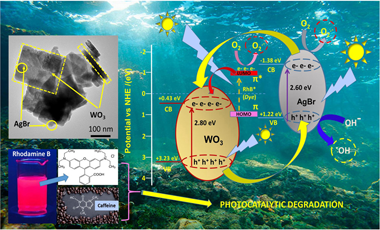
Abstract
AgBr/WO3 composite photocatalysts with different selected molar AgBr/WO3 ratios were prepared and widely characterized by XRD, N2-adsorption, SEM, TEM, UV–visible/DRS and XPS techniques. The samples were tested using rhodamine B (RhB) or caffeine, under two illumination conditions (UV and visible light). Although AgBr and WO3 pristine materials have relatively low band gap values (2.6 eV and 2.8 eV, respectively), they exhibit low or no photocatalytic activity under visible light, at least for caffeine degradation. This fact may be mainly related to a high recombination rate of photogenerated charge carriers in these samples. However, the coupling of both leads to a substantial improvement in the degradation of caffeine and RhB under both UV and visible lighting conditions. The increased photocatalytic activity found in the coupled systems with respect to the pristine materials can be attributed to the formation of a type II heterostructure in the coupled AgBr/WO3 samples. Our results show that for AgBr/WO3 coupled systems, kinetic degradation profiles have clear dependence on the molar percentages of the coupled pristine materials, as well as on the nature (sensitizing or not sensitizing effect) of the substrate. For caffeine photodegradation, the best performance was obtained when AgBr/WO3(10–15%) catalysts were used. The AgBr/WO3(20%) sample showed the best photocatalytic activity for rhodamine B degradation, exhibiting also excellent dark adsorption capacity (40–45%). Additionally, studies of activity in five consecutive tests showed a good RhB degradation during the successive reuses being involving a N-de-ethylation mechanism with the main O2•− radicals participation; relatively low mineralization percentages were observed, both under UV and visible light conditions. In these successive runs, no silver leaching to the medium was observed but a change from AgBr towards Ag2CO3 and/or AgxO was produced at the catalyst surface. These features should be known in the use of these systems as potential photocatalysts for practical applications.
June, 2021 · DOI: 10.1016/j.jallcom.2021.159191
Materiales de Diseño para la Energía y Medioambiente
Swelling layered minerals applications: A solid state NMR overview
Pavon, E; Alba, MDProgress in Nuclear Magnetic Resonance Spectroscopy, 124 (2021) 99-128 DOI: 10.1016/j.pnmrs.2021.04.001
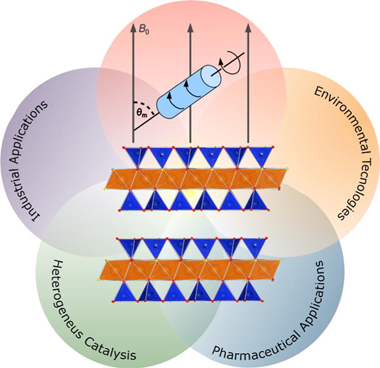
Abstract
Swelling layered clay minerals form an important sub-group of the phyllosilicate family. They are characterized by their ability to expand or contract in the presence or absence of water. This property makes them useful for a variety of applications, ranging from environmental technologies to heteroge-neous catalysis, and including pharmaceutical and industrial applications. Solid State Nuclear Magnetic Resonance (SS-NMR) has been extensively applied in the characterization of these materials, providing useful information on their dynamics and structure that is inaccessible using other characterization methods such as X-ray diffraction. In this review, we present the key contributions of SS-NMR to the understanding of the mechanisms that govern some of the main applications associated to swelling clay minerals. The article is divided in two parts. The first part presents SS-NMR conventional applications to layered clay minerals, while the second part comprises an in-depth review of the information that SS-NMR can provide about the different properties of swelling layered clay minerals.
June, 2021 · DOI: 10.1016/j.pnmrs.2021.04.001
Química de Superficies y Catálisis
Dehydration of glucose to 5-Hydroxymethlyfurfural on bifunctional carbon catalysts
Bounoukta, CE; Megias-Sayago, C; Ammari, F; Ivanova, S; Monzon, A; Centeno, MA; Odriozola, JAApplied Catalysis B-Environmental, 286 (2021) 119938 DOI: 10.1016/j.apcatb.2021.119938
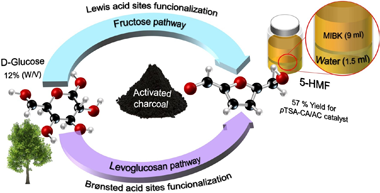
Abstract
The proposed study tries to reply on one important question concerning glucose dehydration: What is the role of bare or tandem Lewis/Bronsted acid sites in the reaction and which are better? A series of mono and bifunctional catalyst are designed and screened for the glucose dehydration reaction. The results clearly reveal that catalyst activity is a function of catalyst composition. The presence of Lewis sites the reaction toward first step isomerization, while the Brunsted acid dehydrate directly glucose to HMF via levoglucosane intermediate. This study proposed also a kinetic modelling of the included reactions and their contrast with the empirical observations.
June, 2021 · DOI: 10.1016/j.apcatb.2021.119938
Materiales Ópticos Multifuncionales - Materiales Coloidales
Highly Versatile Upconverting Oxyfluoride-Based Nanophosphor Films
Ngo, TT; Cabello-Olmo, E; Arroyo, E; Becerro, AI; Ocana, M; Lozano, G; Miguez, HACS Applied Materials & Interfaces, 13 (2021) 30051-30060 DOI: 10.1021/acsami.1c07012
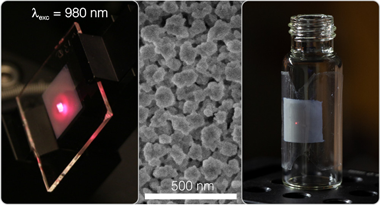
Abstract
Fluoride-based compounds doped with rare-earth cations are the preferred choice of materials to achieve efficient upconversion, of interest for a plethora of applications ranging from bioimaging to energy harvesting. Herein, we demonstrate a simple route to fabricate bright upconverting films that are transparent, self-standing, flexible, and emit different colors. Starting from the solvothermal synthesis of uniform and colloidally stable yttrium fluoride nanoparticles doped with Yb3+ and Er3+, Ho3+, or Tm3+, we find the experimental conditions to process the nanophosphors as optical quality films of controlled thickness between few hundreds of nanometers and several micrometers. A thorough analysis of both structural and photophysical properties of films annealed at different temperatures reveals a tradeoff between the oxidation of the matrix, which transitions through an oxyfluoride crystal phase, and the efficiency of the upconversion photoluminescence process. It represents a significant step forward in the understanding of the fundamental properties of upconverting materials and can be leveraged for the optimization of upconversion systems in general. We prove bright multicolor upconversion photoluminescence in oxyfluoride-based phosphor transparent films upon excitation with a 980 nm laser for both rigid and flexible versions of the layers, being possible to use the latter to coat surfaces of arbitrary shape. Our results pave the way toward the development of upconverting coatings that can be conveniently integrated in applications that demand a large degree of versatility.
June, 2021 · DOI: 10.1021/acsami.1c07012
Reactividad de Sólidos
Paving the Way to Establish Protocols: Modeling and Predicting Mechanochemical Reactions
Gil-Gonzalez, E; Perez-Maqueda, LA; Sanchez-Jimenez, PE; Perejon, AJournal of Physical Chemistry Letters, 12 (2021) 5540-5546 DOI: 10.1021/acs.jpclett.1c01472
Abstract
Parametrization of mechanochemical reactions, or relating the evolution of the reaction progress to the supplied input power, is required both to establish protocols and to gain insight into mechanochemical reactions. Thus, results could be compared, replicated, or scaled up even under different milling conditions, enlarging the domains of application of mechanochemistry. Here, we propose a procedure that allows the parametrization of mechanochemical reactions as a function of the supplied input power from the direct analysis of the milling experiments in a model-free approach, where neither the kinetic model function nor the rate constant equation are previously assumed. This procedure has been successfully tested with the mechanochemical reaction of CH3NH3PbCl3, enabling the possibility to make predictions regardless of the milling device as well as gaining insight into the reaction dynamic. This methodology can work for any other mechanical reaction and definitely paves the way to establish mechanochemistry as a standard synthetic procedure.
June, 2021 · DOI: 10.1021/acs.jpclett.1c01472
Química de Superficies y Catálisis
Stepping toward Efficient Microreactors for CO2 Methanation: 3D-Printed Gyroid Geometry
Baena-Moreno, FM; Gonzalez-Castano, M; de Miguel, JCN; Miah, KUM; Ossenbrink, R; Odriozola, J.A.ACS Sustainable Chemistry & Engineering, 9 (2021) 8198-8206 DOI: 10.1021/acssuschemeng.1c01980
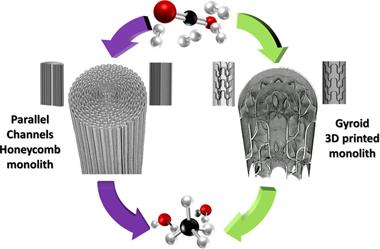
Abstract
This work presents a comparative study toward the development of efficient microreactors based on three-dimensional (3D)-printed structures. Thus, the study evaluates the influence of the metal substrate geometry on the performance of structured catalysts for the CO2 methanation reaction. For this purpose, the 0.5%Ru-15%Ni/MgAl2O4 catalyst is washcoated over two different micromonolithic metal substrates: a conventional parallel channel honeycomb structure and a novel 3D-printed structure with a complex gyroid geometry. The effect of metal substrate geometry is analyzed for several CO2 sources including ideal flue gas atmospheres and the presence of residual CH4 and CO in the flue gas, as well as simulated biogas sources. The advantages of the gyroid 3D complex geometries over the honeycomb structures are shown for all evaluated conditions, providing in the best-case scenario a 14% improvement in CO2 conversion. Moreover, this contribution shows that systematically tailoring geometrical features of structured catalysts becomes an effective strategy to achieve improved catalyst performances independent of the flue gas composition. By enhancing the transport processes and the gas-catalyst interactions, the employed gyroid 3D metal substrates enable boosted CO2 conversions and greater CH4 selectivity within diffusion-controlled regimes.
June, 2021 · DOI: 10.1021/acssuschemeng.1c01980
Reactividad de Sólidos
Kinetic study of complex processes composed of non-independent stages: pyrolysis of natural rubber
Perejon, A; Sánchez-Jiménez, PE; García-Garrido, C; Pérez-Maqueda, LAPolymer Degradation and Stability, 188 (2021) 109590 DOI: 10.1016/j.polymdegradstab.2021.109590
Abstract
In this work, it is proposed a method for studying kinetics of complex processes composed of non-independent stages. In this method, the variable contribution of the different stages as a function of the heating schedule is taken into account. The method involves the simultaneous kinetic analysis of a set of experimental data registered under linear heating rate conditions, without any previous assumptions regarding the kinetic models followed by the stages or their corresponding activation energies.
The method has been tested with the kinetic analysis of the pyrolysis of natural rubber, since the kinetics of this process is complex and depends on temperature and heating schedule. It is demonstrated that the behavior of the experimental curves can be accurately predicted with the kinetic parameters calculated by the proposed methodology.
The kinetic analysis presented here could be applied to other complex processes as those found in pyrolysis, without the need of using oversimplified kinetic models that could yield significant errors when used in real applications.
June, 2021 · DOI: 10.1016/j.polymdegradstab.2021.109590
Química de Superficies y Catálisis
In-situ HDO of guaiacol over nitrogen-doped activated carbon supported nickel nanoparticles
Jin, Wei; Pastor-Perez, Laura; Villora-Pico, Juan J.; Mercedes Pastor-Blas, M.; Odriozola, Jose A.; Sepulveda-Escribano, Antonio; Ramirez Reina, TomasApplied Catalysis A-General, 620 (2021) 118033 DOI: 10.1016/j.apcata.2021.118033
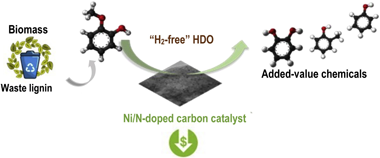
Abstract
In-situ hydrodeoxygenation of guaiacol over Ni-based nitrogen-doped activated carbon supported catalysts is presented in this paper as an economically viable route for bio-resources upgrading. The overriding concept of this paper is to use water as hydrogen donor for the HDO reaction, suppressing the input of external highpressure hydrogen. The effect of nitrogen sources, including polypyrrole (PPy), polyaniline (PANI) and melamine (Mel) on the structural, electronic and ultimately of catalytic features of the designed materials have been addressed. Nitrogen-doped samples are more active than the undoped counterparts in the "H2-free" HDO process. For instance, the conversion of guaiacol increased by 8 % for Ni/PANI-AC compared to that of Ni/AC catalysts. The superior performance of Ni/NC can be attributed to the acid-base properties and modified electronic properties, which favours the C-O cleavage and water activation as well as enhances dispersion of Ni particles on the catalysts' surface.
June, 2021 · DOI: 10.1016/j.apcata.2021.118033
Materiales Ópticos Multifuncionales
The Role of the Atmosphere on the Photophysics of Ligand-Free Lead-Halide Perovskite Nanocrystals
Moran-Pedroso, M; Rubino, A; Calvo, ME; Espinos, JP; Galisteo-Lopez, JF; Miguez, HAdvanced Optical Materials, (2021) 2100605 DOI: 10.1002/adom.202100605
Abstract
Lead halide perovskite (LHP) nanocrystals (NCs) have gained attention over the past decade due to their outstanding optoelectronic properties, making them a suitable material for efficient photovoltaic and light emitting devices. Due to its soft nature, these nanostructures undergo strong structural changes upon irradiation, where these light-induced processes are strongly influenced by the environment. Since most processing routes for LHP NCs are based on colloidal approaches, the role of factors such as stabilizing ligands or solvents is usually hard to disentangle from the interaction of external radiation with the perovskite material. Employing a recently proposed synthetic approach, where ligand-free NCs can be grown within metal-oxide-based insulating nanoporous matrices, it has been feasible to perform a clean study of the effect of the surrounding atmosphere on the photophysical properties of perovskite NCs, avoiding the interference of protective capping layers or solvents. Simultaneous light-induced photo-activation and darkening processes are monitored and disentangled, and their relation with bulk and surface processes, respectively, demonstrated.
June, 2021 · DOI: 10.1002/adom.202100605
Química de Superficies y Catálisis
Ni/YMnO3 perovskite catalyst for CO2 methanation
Gonzalez-Castano, M; de Miguel, JCN; Penkova, A; Centeno, MA; Odriozola, JA; Arellano-Garcia, HApplied Materials Today, 23 (2021) 101055 DOI: 10.1016/j.apmt.2021.101055
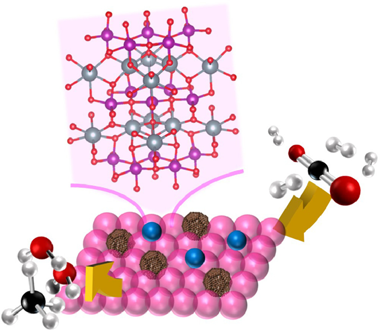
Abstract
This work proposes an innovative Ni catalyst supported over YMnO3 perovskite as a promising catalytic system for CO2 methanation reaction. Under reductive conditions, the attendance of Mn redox couples within the layered perovskite structure promotes the constitution of sub-stoichiometric YMnO3-x units which, by means of the flexible YMnO3-x reorganization capacity, results in boosted anionic mobility's. The competitive turnover frequencies (20.1 and 17.0 s(-1) at 400 degrees C under dry- and steamed- CO2 methanation conditions) displayed by Ni/YMnO3 system were related to the synergism between strongly interacting Ni particles with partially reduced YMnO3-x perovskites. The optimal Ni dispersions, for which no relevant signs of sintering issues were discerned, combined to effective role of oxygen vacancies towards the dissociative activation of CO2 molecules enabled highly active and stable catalytic behaviours with no evidence of cooking phenomena. On evaluating the water presence within CO2 methanation feedstock's, the deprived catalytic behaviour was fundamentally associated to depleted oxygen vacancies concentrations and promoted WGS side reactions.
June, 2021 · DOI: 10.1016/j.apmt.2021.101055
Materiales de Diseño para la Energía y Medioambiente
Pectin-cellulose nanocrystal biocomposites: Tuning of physical properties and biodegradability
Moreno, Ana Gonzalez; Guzman-Puyol, Susana; Dominguez, Eva; Benitez, Jose J.; Segado, Patricia; Lauciello, Simone; Ceseracciu, Luca; Porras-Vazquez, Jose M.; Leon-Reina, Laura; Heredia, Antonio; Heredia-Guerrero, Jose A.International Journal of Biological Macromolecules, 180 (2021) 709-717 DOI: 10.1016/j.ijbiomac.2021.03.126
Abstract
The fabrication of pectin-cellulose nanocrystal (CNC) biocomposites has been systematically investigated by blend-ing both polysaccharides at different relative concentrations. Circular free-standing films with a diameter of 9 cm were prepared by simple solution of these carbohydrates in water followed by drop-casting and solvent evaporation. The addition of pectin allows to finely tune the properties of the biocomposites. Textural characterization by AFM showed fibrous morphology and an increase in fiber diameter with pectin content. XRD analysis demonstrated that pectin incorporation also reduced the degree of crystallinity though no specific interaction between both poly-saccharides was detected, by ATR-FTIR spectroscopy. The optical properties of these biocomposites were character-ized for the first time and it was found that pectin in the blend reduced the reflectance of visible light and increased UV absorbance. Thermal stability, analyzed by TGA, was improved with the incorporation of pectin. Finally, pectin-cellulose nanocrystal biocomposites showed a good biodegradability in seawater, comparable to other common bioplastics such as cellulose and low-molecular weight polylactide, among others.
June, 2021 · DOI: 10.1016/j.ijbiomac.2021.03.126
Reactividad de Sólidos
Unveiling mechanochemistry: Kinematic-kinetic approach for the prediction of mechanically induced reactions
Gil-González, E.; Rodríguez-Laguna, M.d.R.; Sánchez-Jiménez, P.E.; Perejón, A.; Pérez-Maqueda, L.A.Journal of Alloys and Compounds, 866 (2021) 158925 DOI: 10.1016/j.jallcom.2021.158925
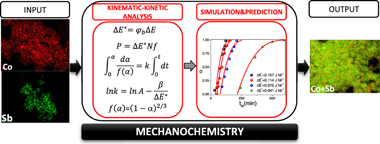
Abstract
Mechanochemistry has attracted a lot of attention over the last few decades with a rapid growth in the number of publications due to its unique features. However, very little is known about how mechanical energy is converted into chemical energy. Most of the published works using mechanochemistry neglect the required attention to the experimental parameters and their effect over the resulting products, what makes extremely difficult to reproduce the results from lab to lab. Moreover, if it is taken into consideration the broad range of experimental conditions used in different studies, it is quite difficult to compare results and set optimum conditions. As a result, mechanochemistry is generally viewed as a "black box". The aim of this work is to provide some insight into mechanochemistry. Thus, a simple kinematic-kinetic approach that allows the full parametrization of mechanically induced reactions is proposed. In an analogous way to thermally activated process, it is shown that kinetic modeling can serve to parametrize and model mechanically induced reactions as a function of the milling parameters with great reliability, thereby gaining prediction capability. As a way of example, this methodology has been applied for the first time to the mechanochemical reaction of Co and Sb to form CoSb3, a skutterudite-type thermoelectric material. Moreover, the universality of this methodology has also been validated with data from the literature. A key feature of the proposed kinematic-kinetic approach is that it can be extrapolated to other mechanically induced reactions, either inorganic or organic.
June, 2021 · DOI: 10.1016/j.jallcom.2021.158925
Materiales Ópticos Multifuncionales
Self-preserving ice layers on CO2 clathrate particles: Implications for Enceladus, Pluto, and similar ocean worlds
Bostrom, M; Esteso, V; Fiedler, J; Brevik, I; Buhmann, SY; Persson, C; Carretero-Palacios, S; Parsons, DF; Corkey, RWAstronomy & Astrophysics, 650 (2021) A54 DOI: 10.1051/0004-6361/202040181
Abstract
Context. Gas hydrates can be stabilised outside their window of thermodynamic stability by the formation of an ice layer - a phenomenon termed self-preservation. This can lead to a positive buoyancy for clathrate particles containing CO2 that would otherwise sink in the oceans of Enceladus, Pluto, and similar oceanic worlds.Aims. Here we investigate the implications of Lifshitz forces and low occupancy surface regions on type I clathrate structures for their self-preservation through ice layer formation, presenting a plausible model based on multi-layer interactions through dispersion forces.Methods. We used optical data and theoretical models for the dielectric response for water, ice, and gas hydrates with a different occupancy. Taking this together with the thermodynamic Lifshitz free energy, we modelled the energy minima essential for the formation of ice layers at the interface between gas hydrate and liquid water.Results. We predict the growth of an ice layer between 0.01 and 0.2 mu m thick on CO, CH4, and CO2 hydrate surfaces, depending on the presence of surface regions depleted in gas molecules. Effective hydrate particle density is estimated, delimiting a range of particle size and compositions that would be buoyant in different oceans. Over geological time, the deposition of floating hydrate particles could result in the accumulation of kilometre-thick gas hydrate layers above liquid water reservoirs and below the water ice crusts of their respective ocean worlds. On Enceladus, the destabilisation of near-surface hydrate deposits could lead to increased gas pressures that both drive plumes and entrain stabilised hydrate particles. Furthermore, on ocean worlds, such as Enceladus and particularly Pluto, the accumulation of thick CO2 or mixed gas hydrate deposits could insulate its ocean against freezing. In preventing freezing of liquid water reservoirs in ocean worlds, the presence of CO2-containing hydrate layers could enhance the habitability of ocean worlds in our Solar System and on the exoplanets and exomoons beyond.
June, 2021 · DOI: 10.1051/0004-6361/202040181
- ‹ previous
- 9 of 37
- next ›




